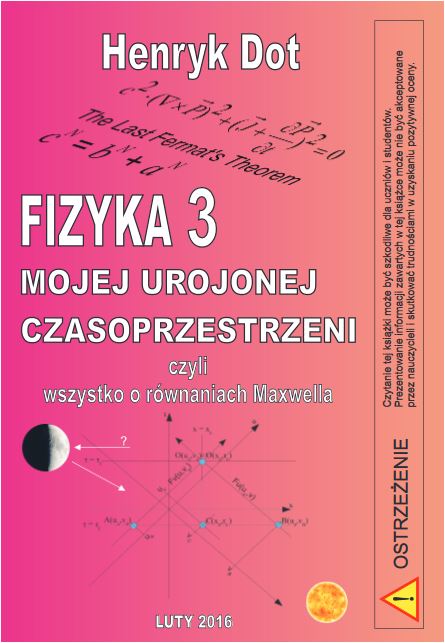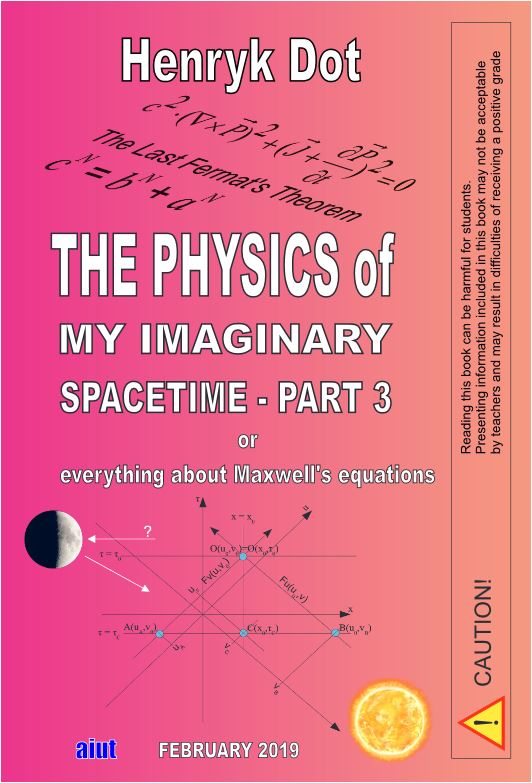★ HenrykDot.com
★
is the online companion to a series of books published by AIUT under the common main title
"Physics of My Imaginary Space-Time" by Henryk Dot.
is the online companion to a series of books published by AIUT under the common main title
"Physics of My Imaginary Space-Time" by Henryk Dot.
Home
Physics 3 - Maxwell
Note from the Author
Table of Contents
What is this book
Historical facts
New aspects
Fully erroneous
Incorrectly interpreted
Physics 3 - Chapter 1
Equations
Complex vectors form
The Most General form
The General Solution
Physics 3 - Chapter 2
Solutions
Initial conditions
Non-homogeneous equation
Solution for three-directions
The four laws
Physics 3 - Supplement
Fermat's proof
Beal's conjecture
Pythagorean triples
Inertial mass
Gravity constans big G
What does the Moon look at?
Physics 3 - Final notes
Final notes
Physics 4 - New book
Entry
Physics 3 - Maxwell
Note from the Author
Table of Contents
What is this book
Historical facts
New aspects
Fully erroneous
Incorrectly interpreted
Physics 3 - Chapter 1
Equations
Complex vectors form
The Most General form
The General Solution
Physics 3 - Chapter 2
Solutions
Initial conditions
Non-homogeneous equation
Solution for three-directions
The four laws
Physics 3 - Supplement
Fermat's proof
Beal's conjecture
Pythagorean triples
Inertial mass
Gravity constans big G
What does the Moon look at?
Physics 3 - Final notes
Final notes
Physics 4 - New book
Entry
Contact
email: henryk.dot(at)aiut.com
"Subject" should begin with
a digit corresponding to the day
of the week., e.g. Sunday=7
"Subject" should begin with
a digit corresponding to the day
of the week., e.g. Sunday=7
Books published by AIUT
are found in libraries according to the list of compulsory copies.
Second Edition of "Fizyka 3"
ISBN 978-83-926856-1-6

can be bought in Warsaw
in the Academic Bookstore
PW Publishing House
Noakowskiego street 18/20
and in Katowice
in the bookstore "Liber"
Bankowa street 11.
(area of Silesian University)
English edition of "Physics"
ISBN 978-83-926856-2-3

is also in libraries
and the distribution method should be asked wydawca@aiut.com.
|
3.1.2. Pythagorean triples Returning to our presented proof – as a “side effect” it allows also for easy way to find possible solutions of (3.1) for
N = 2 (a.k.a. Pythagorean triples). |
|
| b2=((c - a)+x)2=(e+x)2=e2+2‧ e‧ v+x2 and | (3.9) |
| b2=c2- a2=(e+a)2- a2=e2+2‧ e‧ v | (3.10) |
| Comparing (3.9) and (3.10) we obtain: | |
| x2=2‧ (a - x) , | (3.11) |
|
where it can be seen that x must be an even number. We can introduce new integral variable y such that x=2‧ y, then inserting it into (3.11) we obtain: |
|
| |
(3.12) |
|
We can conclude then e and y have to be expressed by following relations:
e=2‧ re2 and
y=re‧ ry , where
re is a divisor of e and
ry is a second divisor of y, besides re. If this were not a case, a, e and y would have common divisor, then this would mean that a and b were not relatively prime. In this case we obtain: |
|
| |
(3.13) |
|
where ry cannot be an even number, since
2 is a divisor of e.
It should be then assumed that: |
|
| a=ry‧ (ry+2‧ re)= (2‧ ry+1)‧ (2‧ (rj+re)+1) , | (3.15a) |
| b=2‧ re‧ (2‧ rj+1)+2‧ re2)= 2‧ re‧ (2‧ rj+re+1) , | (3.15b) |
| c=ry‧ (ry+2‧ re)+2‧ re2= (2‧ rj+1)‧ (2‧ (rj+re)+1)+2‧ re2 | (3.15c) |
| So, we can re-write them as: a=(2‧ ry+1)‧ 2‧ (rj+re)+1)= (2‧ rj+re+1) 2 - re2 , b=2‧ re‧ (2‧ rj+1)+2‧ re2)= 2‧ (2‧ rj+re+1)‧ re , c=(2‧ rj+1)‧ (2‧ (rj+re)+1)+2‧ re2= (2‧ rj+re+1)2+re2 and then they correspond to well-known publicized relations |
|
| a=m2- n2 , b=2‧ m‧ n , c=m2+n2 . | (3.16) |
| Our derived relations (3.15) have additional advantage since there is no restrictions such as in case of relation (3.16) where
m and n cannot be odd numbers at the same time. |
|
© 2020 Henryk Dot -
